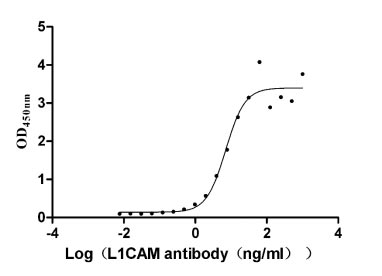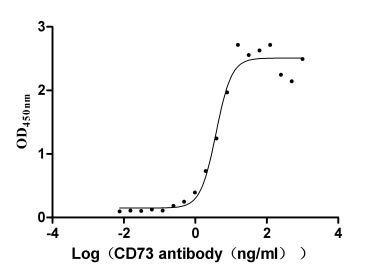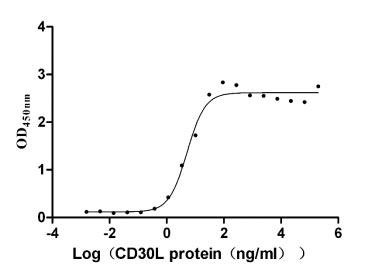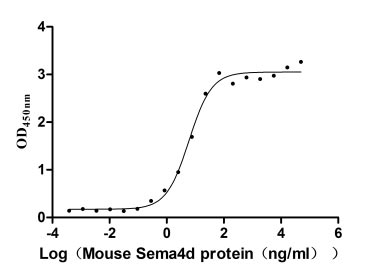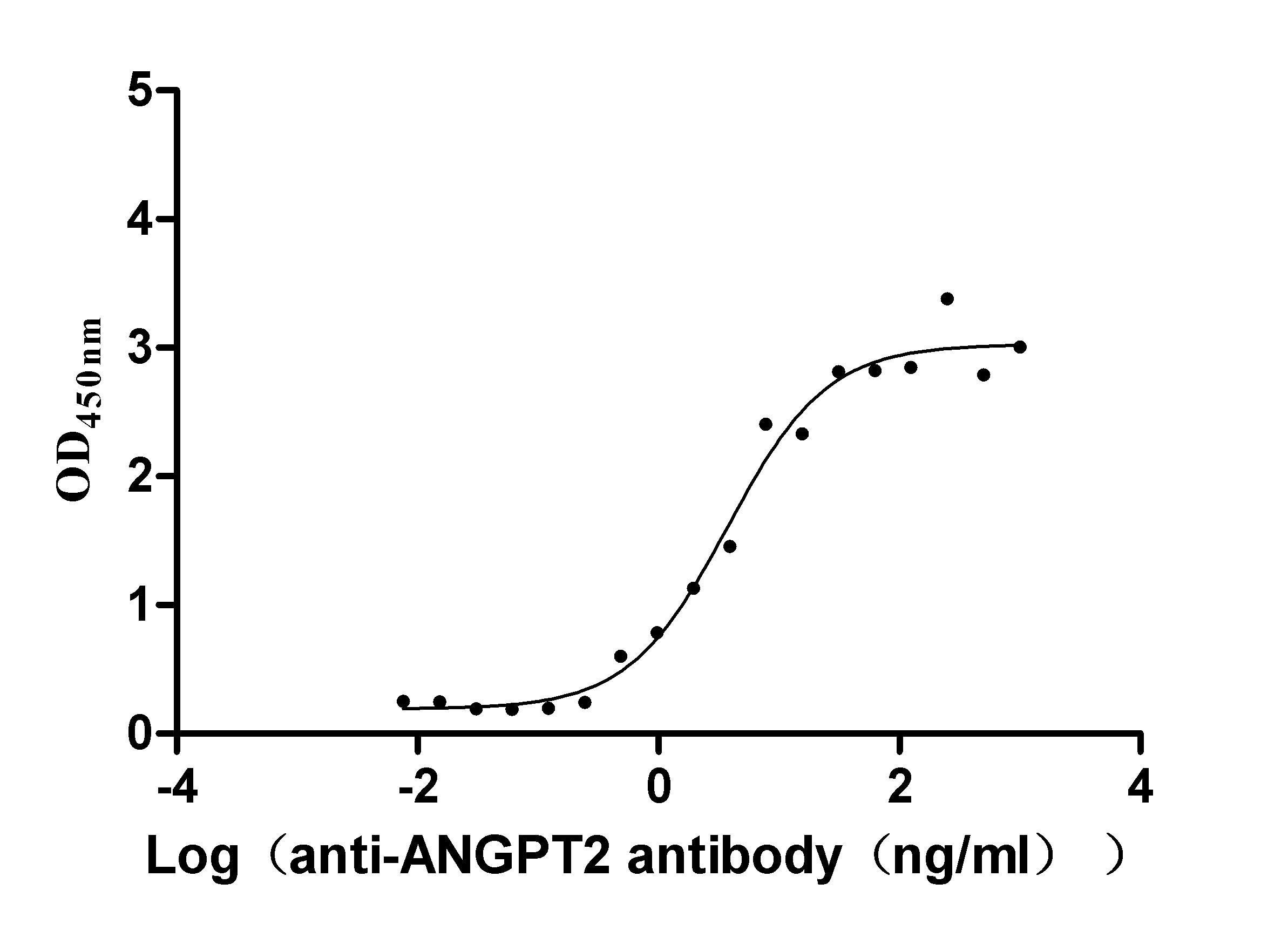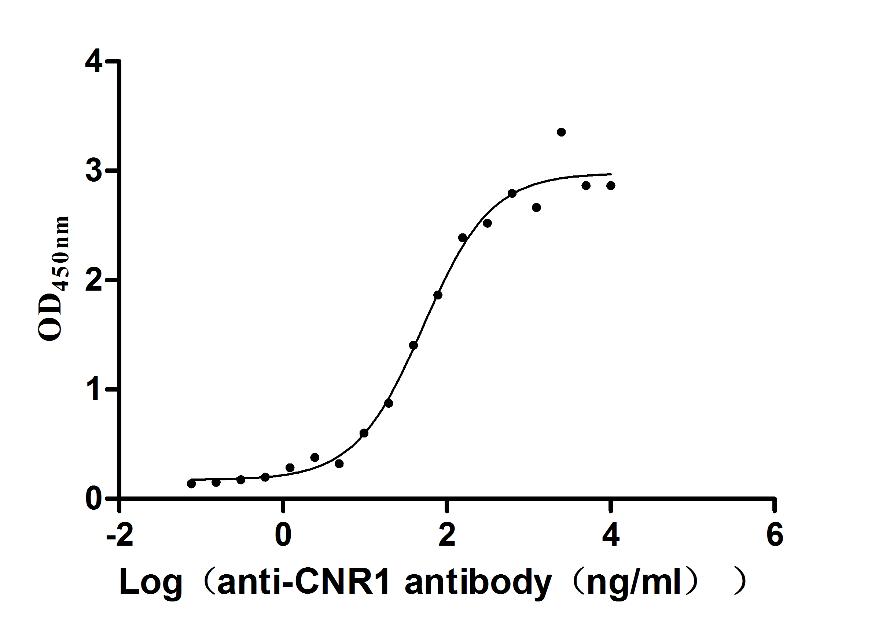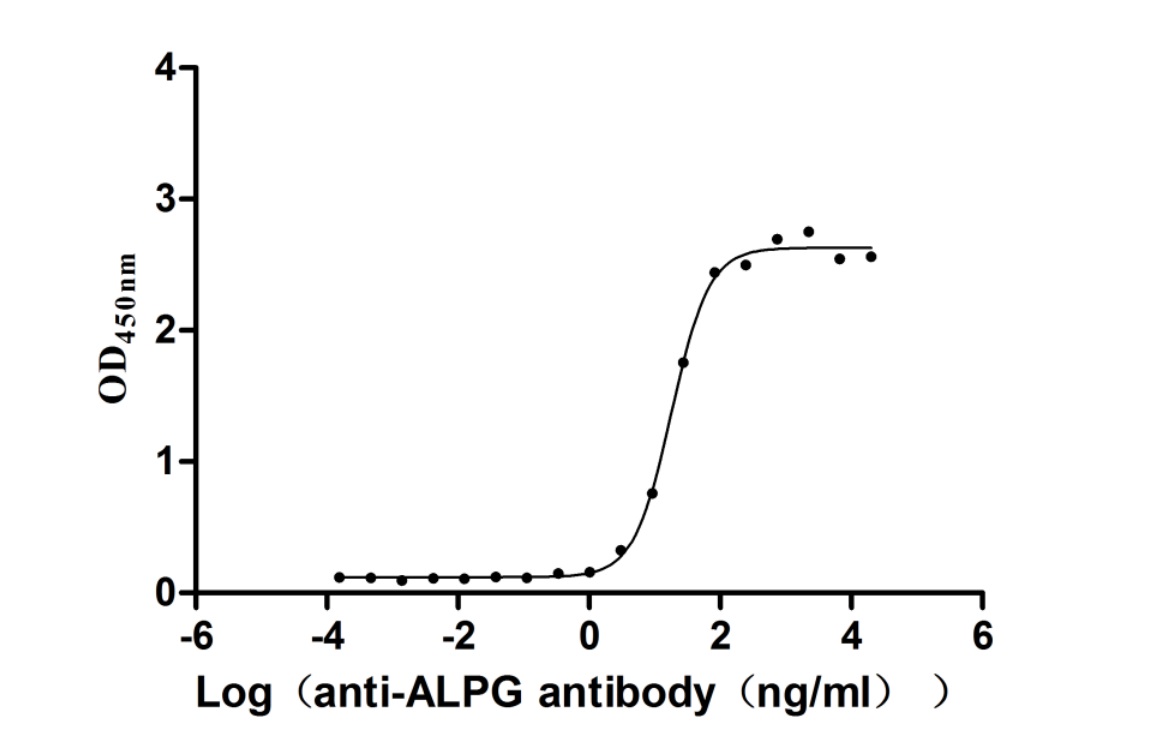Recombinant Human NAD-dependent protein deacylase sirtuin-5, mitochondrial (SIRT5)
-
中文名称:人SIRT5重组蛋白
-
货号:CSB-YP873680HU
-
规格:
-
来源:Yeast
-
其他:
-
中文名称:人SIRT5重组蛋白
-
货号:CSB-EP873680HU
-
规格:
-
来源:E.coli
-
其他:
-
中文名称:人SIRT5重组蛋白
-
货号:CSB-EP873680HU-B
-
规格:
-
来源:E.coli
-
共轭:Avi-tag Biotinylated
E. coli biotin ligase (BirA) is highly specific in covalently attaching biotin to the 15 amino acid AviTag peptide. This recombinant protein was biotinylated in vivo by AviTag-BirA technology, which method is BriA catalyzes amide linkage between the biotin and the specific lysine of the AviTag.
-
其他:
-
中文名称:人SIRT5重组蛋白
-
货号:CSB-BP873680HU
-
规格:
-
来源:Baculovirus
-
其他:
-
中文名称:人SIRT5重组蛋白
-
货号:CSB-MP873680HU
-
规格:
-
来源:Mammalian cell
-
其他:
产品详情
-
纯度:>85% (SDS-PAGE)
-
基因名:
-
Uniprot No.:
-
别名:NAD dependent deacetylase sirtuin 5 ; NAD dependent lysine demalonylase and desuccinylase sirtuin 5 mitochondrial; NAD dependent protein deacylase sirtuin 5 mitochondrial; NAD-dependent protein deacylase sirtuin-5; mitochondrial; Regulatory protein SIR2 homolog 5; Silent mating type information regulation 2 S.cerevisiae homolog 5; Sir2 like 5 ; SIR2-like protein 5; SIR2L5; SIR5_HUMAN; Sirt5; Sirtuin 5; Sirtuin type 5
-
种属:Homo sapiens (Human)
-
蛋白长度:Full Length of Mature Protein
-
表达区域:37-310
-
氨基酸序列SSSM ADFRKFFAKA KHIVIISGAG VSAESGVPTF RGAGGYWRKW QAQDLATPLA FAHNPSRVWE FYHYRREVMG SKEPNAGHRA IAECETRLGK QGRRVVVITQ NIDELHRKAG TKNLLEIHGS LFKTRCTSCG VVAENYKSPI CPALSGKGAP EPGTQDASIP VEKLPRCEEA GCGGLLRPHV VWFGENLDPA ILEEVDRELA HCDLCLVVGT SSVVYPAAMF APQVAARGVP VAEFNTETTP ATNRFRFHFQ GPCGTTLPEA LACHENETVS
-
蛋白标签:Tag type will be determined during the manufacturing process.
The tag type will be determined during production process. If you have specified tag type, please tell us and we will develop the specified tag preferentially. -
产品提供形式:Lyophilized powder
Note: We will preferentially ship the format that we have in stock, however, if you have any special requirement for the format, please remark your requirement when placing the order, we will prepare according to your demand. -
复溶:We recommend that this vial be briefly centrifuged prior to opening to bring the contents to the bottom. Please reconstitute protein in deionized sterile water to a concentration of 0.1-1.0 mg/mL.We recommend to add 5-50% of glycerol (final concentration) and aliquot for long-term storage at -20℃/-80℃. Our default final concentration of glycerol is 50%. Customers could use it as reference.
-
储存条件:Store at -20°C/-80°C upon receipt, aliquoting is necessary for mutiple use. Avoid repeated freeze-thaw cycles.
-
保质期:The shelf life is related to many factors, storage state, buffer ingredients, storage temperature and the stability of the protein itself.
Generally, the shelf life of liquid form is 6 months at -20°C/-80°C. The shelf life of lyophilized form is 12 months at -20°C/-80°C. -
货期:Delivery time may differ from different purchasing way or location, please kindly consult your local distributors for specific delivery time.Note: All of our proteins are default shipped with normal blue ice packs, if you request to ship with dry ice, please communicate with us in advance and extra fees will be charged.
-
注意事项:Repeated freezing and thawing is not recommended. Store working aliquots at 4°C for up to one week.
-
Datasheet :Please contact us to get it.
相关产品
靶点详情
-
功能:NAD-dependent lysine demalonylase, desuccinylase and deglutarylase that specifically removes malonyl, succinyl and glutaryl groups on target proteins. Activates CPS1 and contributes to the regulation of blood ammonia levels during prolonged fasting: acts by mediating desuccinylation and deglutarylation of CPS1, thereby increasing CPS1 activity in response to elevated NAD levels during fasting. Activates SOD1 by mediating its desuccinylation, leading to reduced reactive oxygen species. Activates SHMT2 by mediating its desuccinylation. Modulates ketogenesis through the desuccinylation and activation of HMGCS2. Has weak NAD-dependent protein deacetylase activity; however this activity may not be physiologically relevant in vivo. Can deacetylate cytochrome c (CYCS) and a number of other proteins in vitro such as UOX.
-
基因功能参考文献:
- In human beings, SIRT5 gene encodes for four SIRT5 protein isoforms, namely SIRT5iso1, SIRT5iso2, SIRT5iso3, and SIRT5iso4. SIRT5(iso1-3) were mitochondria-localized, while SIRT5(iso4) localized mainly in cytoplasm. SIRT5(iso2-4) had little deacylase activity comparing with SIRT5(iso1). PMID: 29932920
- miR-299-3p suppresses migration, invasion and proliferation of Hepatocellular carcinoma cells via directly targeting SIRT5 PMID: 30170358
- High SIRT5 expression is associated with Cancer Cell Proliferation. PMID: 29180469
- The DNA variants and SNPs identified in acute Myocardial infection (AMI) patients may change SIRT5 level by affecting activity of SIRT5 gene promoter, contributing to the AMI development as a risk factor. PMID: 29981421
- In this study, we summarize biological functions of SIRT5 reported in normal tissues and in cancer and discuss potential mechanisms whereby SIRT5 may impact tumorigenesis, particularly focusing on its reported roles in metabolic reprogramming. Finally, we review current efforts to target SIRT5 pharmacologically PMID: 28707979
- The roles of the CDK2/SIRT5 axis in gastric cancer. PMID: 29896817
- SIRT5 gene has an important regulatory role in liver carcinogenesis, and may function as a novel potential therapeutic target for HCC. PMID: 29115436
- This study showed that SIRT5 supports the anaplerotic entry of glutamine into the TCA cycle in malignant phenotypes of CRC via activating GLUD1. PMID: 29416026
- Results show that SIRT5 binds to, desuccinylates and inhibits PKM2 activity. Increased levels of reactive oxygen species (ROS) decreases succinylation and activity of PKM2 by increasing its binding to SIRT5. Moreover, inhibition of SIRT5 suppresses tumor cell proliferation through desuccinylation of PKM2 K498. PMID: 28036303
- The function of the three mitochondrial sirtuins (SIRT3, SIRT4, SIRT5) and their role in disease are reviewed. PMID: 27164052
- Our study uncovers a SIRT5-dependent mechanism that regulates cellular NADPH homeostasis and redox potential by promoting IDH2 desuccinylation and G6PD deglutarylation. PMID: 27113762
- Results demonstrated presence of endogenous SIRT5 in mitochondria of cultured SH-EP cells, identified down-regulation of cellular oxidative stress by SIRT5 as one of the possible mechanisms mediating the anti-apoptotic effect of SIRT5 in SH-EP cells. PMID: 27577743
- Data (including data from studies using knockout mice) suggest that SIRT5 is targeted to protein complexes on the inner mitochondrial membrane via affinity for cardiolipin to promote respiratory chain function, particularly Complex I and Complex II; SIRT5 expression is observed in inner mitochondrial membrane of periportal hepatocytes. PMID: 28458255
- a side chain-to-side chain cyclic pentapeptide harboring a central N(epsilon)-carboxyethyl-thiocarbamoyl-lysine residue behaved as a strong and selective (versus human SIRT1/2/3/6) inhibitor against human SIRT5-catalyzed deacylation reaction. PMID: 27626398
- mutual cooperation between Y102 and R105 residues in promoting the desuccinylation versus deacetylation reaction in SIRT5. PMID: 27023330
- Data showed that SIRT5 was involved in protein post-translational modifications through its potent demalonylase, desuccinylase, and deglutarylase activities. Also, the protein was found in the mitochondrial, cytoplasmic, and nuclear compartments. [review] PMID: 25717114
- Results show that mitochondrial sirtuins SIRT3, SIRT4, and SIRT5 can promote increased mitochondrial respiration and cellular metabolism and respond to excess glucose by inducing a coordinated increase of glycolysis and respiration. PMID: 25165814
- This study demonstrated that SIRT15 downregulation in the liver of non-alcoholic fatty liver disease patients. PMID: 25361925
- Results suggest a role for SIRT5 in influencing oocyte quality and in vitro fertilization outcomes. PMID: 23978077
- SIRT1/SIRT5-mediated PML deacetylation plays a role in the regulation of cancer cell survival. PMID: 25032863
- The results reveal the Sirt5 substrate acyl selectivity and its molecular basis and enable the design of inhibitors for Sirt5. PMID: 25111069
- High SIRT5 expression facilitates cancer cell growth and drug resistance in non-small cell lung cancer. PMID: 25070488
- Expression of SIRT5 in the entorhinal cortex, hippocampus, and white matter increases during the progression of Alzheimer disease. It is seen in activated microglia. PMID: 24464653
- These results reveal a novel post-translational regulation of SOD1 by means of succinylation and SIRT5-dependent desuccinylation, which is important for the growth of lung tumor cells. PMID: 24140062
- Downregulation of SIRT5 is associated with head and neck squamous cell carcinoma. PMID: 23475622
- Analysis of Sirt5 structures and activity data suggest that an Arg/succinate interaction is the molecular basis of the differential nicotinamide sensitivities of the two Sirt5 activities. PMID: 23028781
- The bicyclic intermediate structure provides insights into the desuccinylation mechanism of human sirtuin 5 (SIRT5). PMID: 22767592
- NAD(+)-dependent SIRT deacetylase has a role in regulating the expression of mitochondrial steroidogenic P450 PMID: 22585829
- we demonstrate that Sirt5, a member of the class III lysine deacetylases, can catalyze lysine demalonylation and lysine desuccinylation reactions both in vitro and in vivo PMID: 21908771
- study found that Sirt5 is an efficient protein lysine desuccinylase and demalonylase in vitro; protein lysine succinylation may represent a posttranslational modification that can be reversed by Sirt5 in vivo PMID: 22076378
- SIRT5 represents a risk factor for mitochondrial dysfunction-related diseases, including Parkinson's, through accelerated molecular aging of disease-related genes. PMID: 20887790
- these results indicate that human SIRT5 potentially controls various primate-specific functions via two isoforms with different intracellular localizations or stabilities. PMID: 21143562
- SIRT5 consists of eight exons and is found in two isoforms, which encode a 310 aa and a 299 aa protein, respectively. PMID: 16484774
- Analyses did not yield convincing evidence for associations of schizophrenia with SIRT5. PMID: 16827919
- Results describe the substrates and regulation mechanisms for the human mitochondrial sirtuins Sirt3 and Sirt5. PMID: 18680753
显示更多
收起更多
-
亚细胞定位:Mitochondrion matrix. Mitochondrion intermembrane space. Cytoplasm, cytosol. Nucleus. Note=Mainly mitochondrial. Also present extramitochondrially, with a fraction present in the cytosol and very small amounts also detected in the nucleus.; [Isoform 1]: Cytoplasm. Mitochondrion.; [Isoform 2]: Mitochondrion.
-
蛋白家族:Sirtuin family, Class III subfamily
-
组织特异性:Widely expressed.
-
数据库链接:
Most popular with customers
-
Recombinant Human Hepatocyte growth factor receptor (MET), partial (Active)
Express system: Mammalian cell
Species: Homo sapiens (Human)
-
Recombinant Human Neural cell adhesion molecule L1 (L1CAM), partial (Active)
Express system: Mammalian cell
Species: Homo sapiens (Human)
-
Recombinant Human 5'-nucleotidase (NT5E) (Active)
Express system: Mammalian cell
Species: Homo sapiens (Human)
-
Recombinant Human Tumor necrosis factor ligand superfamily member 8 (TNFSF8), partial (Active)
Express system: Mammalian cell
Species: Homo sapiens (Human)
-
Recombinant Mouse Semaphorin-4D (Sema4d), partial (Active)
Express system: Mammalian cell
Species: Mus musculus (Mouse)
-
Recombinant Dog Angiopoietin-2 (ANGPT2) (Active)
Express system: Mammalian cell
Species: Canis lupus familiaris (Dog) (Canis familiaris)
-
Recombinant Human Cannabinoid receptor 1 (CNR1)-VLPs (Active)
Express system: Mammalian cell
Species: Homo sapiens (Human)
-
Recombinant Human Alkaline phosphatase, germ cell type (ALPG) (Active)
Express system: Mammalian cell
Species: Homo sapiens (Human)



